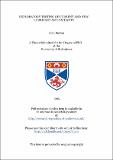Files in this item
Exploratory testing of current and new lubricant antioxidants
Item metadata
| dc.contributor.advisor | Walton, John Christopher | |
| dc.contributor.author | Burton, Alan | |
| dc.coverage.spatial | 229 p. | en_US |
| dc.date.accessioned | 2018-07-09T10:46:30Z | |
| dc.date.available | 2018-07-09T10:46:30Z | |
| dc.date.issued | 1995-07 | |
| dc.identifier.uri | https://hdl.handle.net/10023/15110 | |
| dc.description.abstract | Chapter one is a general introduction to lubricant degradation. Subjects discussed include the problems associated with oil degradation, the mechanism of the autoxidation process, products generated by autoxidation, methods used for controlling the autoxidation process, the reasoning for constant lubricant development and the conventional industrial screening tests. The concept of the radical clock, and the rationale for testing an antioxidants ability to trap alkyl radicals, are also introduced. Chapter two deals with the measurement of the rate constant, kH, at which the aminyl hydrogen is removed by alkyl radicals from 4,4'-disubstituted diphenylamines. The method used was based on the ability of some radicals to rearrange irreversibly. The radical clocks employed for this study were the 5-hexenyl and the neophyl rearrangements. Results indicated that the 5-hexenyl radical rearrangement was too fast so all the quantitative results were obtained using the neophyl rearrangement. The alkyl radicals were generated by the decomposition of a diacyl peroxide. Problems encountered with this source were radical disproportionation and heterolytic scission, both of which form 2-methyl-2-propenylbenzene. Various methods of overcoming these problems were discussed and, by taking into account the alkene formation, kH was obtained for a variety of diarylamines at differing temperatures. From these results the Arrhenius pre-exponential factors and activation energies were obtained. Log kH was found to correlate with op+ values for the para substituents. The experimental results show that diphenylamines with electron releasing substituents in the para position were the most efficient at trapping alkyl radicals; this was found to correlate with kinetic studies involving peroxyl radicals. Chapter three describes the measurement of the rate constant, kH, at which the phenolic hydrogen is removed by alkyl radicals from 2,6-di-t-butyl-4-substituted phenols. For this study the neophyl radical rearrangement was used. Solutions to problems associated with radical disproportionation and heterolytic scission are again suggested. The experimental results show that phenols with electron withdrawing substituents in the para-position were the most efficient at trapping alkyl radicals. Kinetic studies with peroxyl radicals give the opposite result in that phenols with electron releasing substituents in the para position were the most efficient. Chapter four deals with the testing of 4,4'-disubstituted diphenylamines with existing industrial screening tests. The results show that in general diphenylamines with electron releasing substituents in the para position were the most efficient antioxidants. The effect that the lubricant basestock has on these results was also investigated. Chapter five deals with slow release antioxidants. These compounds were designed to release a fresh supply of antioxidant as the original materials are consumed. Compounds under consideration were the N-amides, N-silyl diphenylamines, N-oxides and N-alkyl diphenylamines. Of these only the N-alkyl diphenylamines were further investigated using flash vacuum pyrolysis (FVP) and the industrial screening tests. The FVP results indicated that the N-alkyl diphenylamines were decomposing by cleavage of the N-C bond, although other mechanisms were probably important. The industrial screening tests indicated that the decomposition involved the oxidation of the nitrogen to the N-oxide which easily decomposed to the hydroxylamine, an active antioxidant. Chapter six gives a brief summary of the experimental results and the conclusions derived from them. | en_US |
| dc.language.iso | en | en_US |
| dc.publisher | University of St Andrews | |
| dc.subject.lcc | TP691.B9 | |
| dc.title | Exploratory testing of current and new lubricant antioxidants | en_US |
| dc.type | Thesis | en_US |
| dc.contributor.sponsor | Exxon Chemical Ltd. | en_US |
| dc.type.qualificationlevel | Doctoral | en_US |
| dc.type.qualificationname | PhD Doctor of Philosophy | en_US |
| dc.publisher.institution | The University of St Andrews | en_US |
This item appears in the following Collection(s)
Items in the St Andrews Research Repository are protected by copyright, with all rights reserved, unless otherwise indicated.

